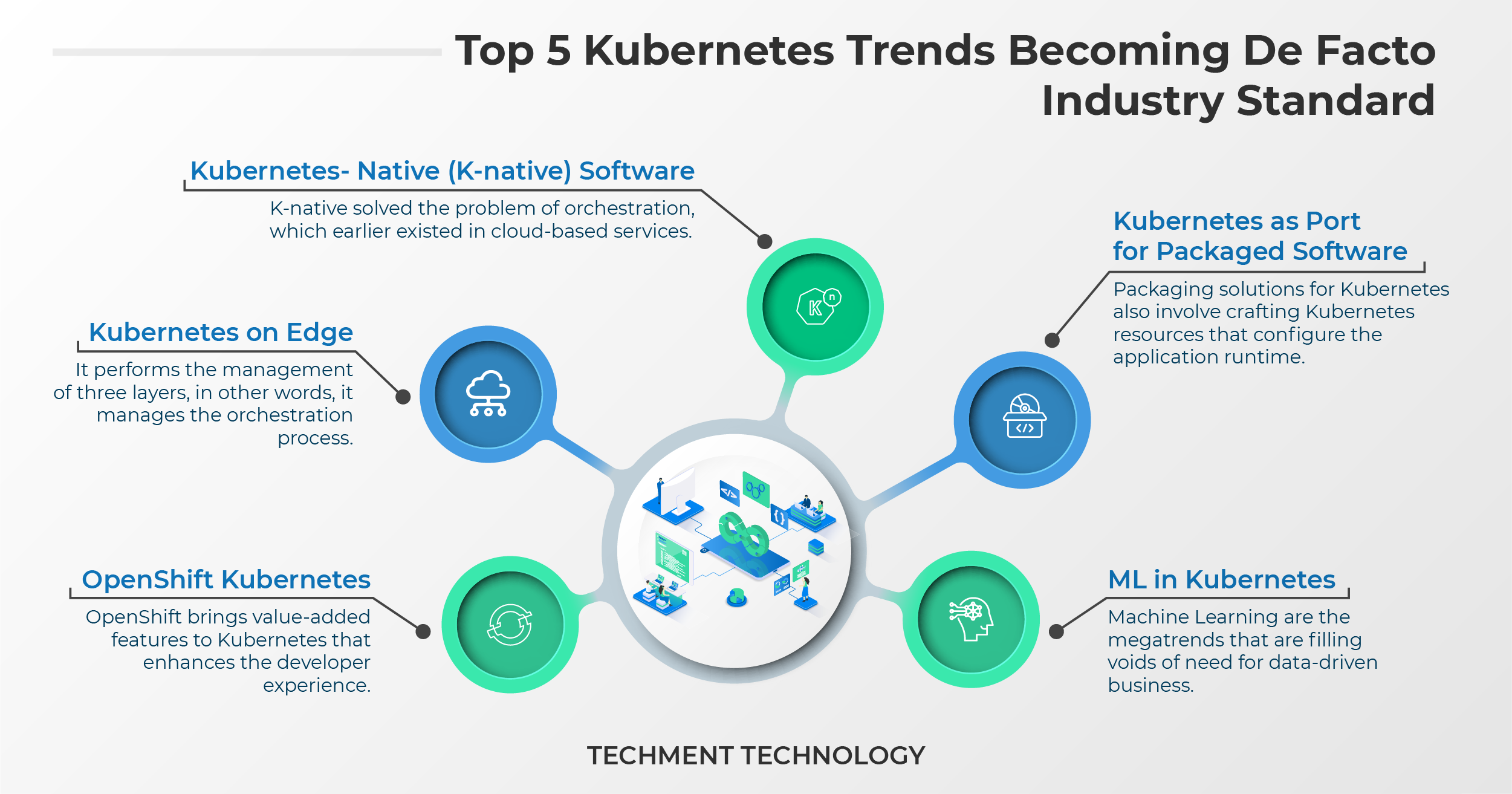Rise in Kubernetes Adoption
The need to deliver new digital services faster has forced companies to migrate to containers. Containers have been one of the most disruptive and useful technologies ever to hit the IT companies. Developers benefit because they can access the resources they need, enable them to be more efficient and innovate faster, and increase infrastructure utilization.
Containerization is the packaging of software codes with operating system libraries and dependencies so that they can run consistently and uniformly on any infrastructure. It encapsulates an application as a single package of software allowing it to write the code once and run on any infrastructure.
Kubernetes is one such open-source platform, portable & extensible that manages containerized packages and services. It provides a framework to run distributed systems resiliently. Kubernetes comes into the picture when one container fails and the need for another container arises, hence, taking care of failover and scaling.
Its supremacy over other containerized platforms (like AWS Fargate, Microsoft Azure, etc.) is not only because of scaling and failover provisions but also because it is lightweight, built for the multi-cloud, public cloud, and hybrid- cloud. According to VMware, (a virtualization technology company), the adoption of Kubernetes has grown to 48% in 2020, from 27% in 2018. If you are building a scalable container-based solution, this is where the Kubernetes orchestration platform comes into play. It is API- driven architecture that operates independently, enables greater autonomy, and productivity. You can use the Kubernetes API to automate various resource provisioning and management tasks, and prepare for future cloud migrations.
What popularizes Kubernetes?
Kubernetes became standard for container management systems since it can be deployed in various scenarios like in the hybrid cloud, multi-cloud, and on-premise. On-premise Kubernetes means having one’s own data center and deploying a Kubernetes-cluster with the same Kubernetes features i.e., you need to automate the deployment process, choose networking solution, choose storage solution, handle security and authenticate for your own data center.
Also, Kubernetes is popularizing because of following reasons:
- Load balancing: When traffic in a container saturates, it balances load and distributes the network traffic, so that deployment is stable.
- Automated State Change: You can describe the desired state required for your container and it will change the state at the desired rate. Hence, the automation for deployment, removing existing containers, and adopting all resources to new containers, are good reasons for favoring Kubernetes.
- Self-Healing: It easily does the task of filtering and replacing containers. Kubernetes easily restarts the failed containers, kills or replaces the non-responding containers or ones that don’t fit in user-defined parameters.
- Protects Sensitive Information: It lets you store and manage secret information like passwords.
It’s easier to handle the behavior of Kubernetes, also, it handles a wide variety of workloads so choosing one for an application running on a container won’t be regretted.
Top 5 Kubernetes Trends Becoming De Facto Industry Standard
Enterprises adopt new technologies, frameworks, or tools when they find it matching with their intended solution. Kubernetes is a buzzword these days and IT professionals are more inclined towards it as it provides benefits of scaling the infrastructure especially for enterprises employing multiple services.

- Kubernetes- Native (K-native) Software: Earlier in Kubernetes software was to be run through containerization which has its fixed functionality and architecture. Now developers have moved from virtualization of application, to direct development of application on Kubernetes and container clusters. This concept is not away from cloud-native, where Kubernetes-native will be specifically built for Kubernetes, which is an analogy for cloud intended cloud-native structure.
K-native solved the problem of orchestration, which earlier existed in cloud-based services. Kubernetes application developers are relying more on this direct method of development. - Kubernetes on Edge: When centralizing Kubernetes on edge, it performs the management of three layers, in other words, it manages the orchestration process. On edge, the data centers collect data and pass it to middle layers which consist of edge nodes and regional nodes that perform data acquisition, data aggregation, and transferring data back and forth. Here Kubernetes management simplifies the orchestration task for all three layers. Another way of Kubernetes on edge is, forming a micro-cloud on the Kubernetes node on the server, on customers’ premises. Running heavy applications on the server is done with the help of Kubernetes. Kubeflow is a project that provides a toolkit to run AI/ML on Kubernetes. This helps data scientists to build and experiment with ML pipelines and deploy them to various environments.
- OpenShift Kubernetes: The OpenShift developed by Red-Hat is 100% based on Kubernetes that provides, on-cloud or on-premise service of “Platform-as-a-Service” (PaaS), built around docker containers. OpenShift brings value-added features to Kubernetes that enhances the developer experience. The eminence of OpenShift lies in the API it provides that is 100% Kubernetes i.e., it is open-source.
- Kubernetes as Port for Packaged Software: With Kubernetes, many companies are trying to operate standard software on a container basis. Application decomposition is brought into practice to create new possibilities for making the packaged software work. Independent software vendors can easily provide standard solutions directly to Kubernetes.
Packaging solutions for Kubernetes also involve crafting Kubernetes resources that configure the application runtime. Some applications like content management systems, CI tools, databases, etc. are not developed at the user end rather configured to customize for specific use cases. So such applications could be made available with packaged software.
Ruckstack is a modern application server that provides a Kubernetes system designed for simplicity and performance. It acts more like a virtual machine than as a data center.
- ML in Kubernetes: Apart from Edge Computing and IoT, Artificial Intelligence and Machine Learning are other megatrends that are filling voids of need for data-driven business. Companies are identifying the use cases of ML for enhancing performance.
The ML solutions need to be broken down and go through different frameworks to learn data while migrating from one operation to the next. This methodology of abstraction and implementation becomes easy with Kubernetes. If a company wants to develop a new digital platform based on cloud technology and architecture, the team must be familiar with technology, have goals in mind, and know how to achieve them. These Cloud-Native and Kubernetes trends will be particularly needed to guarantee the performance of existing systems to absolutely implement new digital platform conditions.
Trends in Kubernetes Reshaping Digital IT Operations
Kubernetes is growing in popularity for use cases in critical industries such as finance, educational technology, and traditional enterprise IT. In finance and banking, customer expectations revolve around online banking services and Kubernetes enables the rapid deployment of ideas and scales the services, and manage peak demands.
Kubernetes has made it much more convenient for companies to develop containerized applications. Companies can move forward in adopting innovative technologies with reliability. By realizing the good implementations and its managing and controlling capability, businesses have widely started embracing it.
The future of IT will include greater interoperability, seamlessly integrated experiences, predictive analytics, automation, machine learning decision making, data exhaustion, real-time addition, and more. Containerized applications hosted on Kubernetes provide these attributes to become the building blocks of modern IT infrastructure. The future of IT requires a platform that supports all of these services in data centers and in containers.
 All Posts
All Posts


